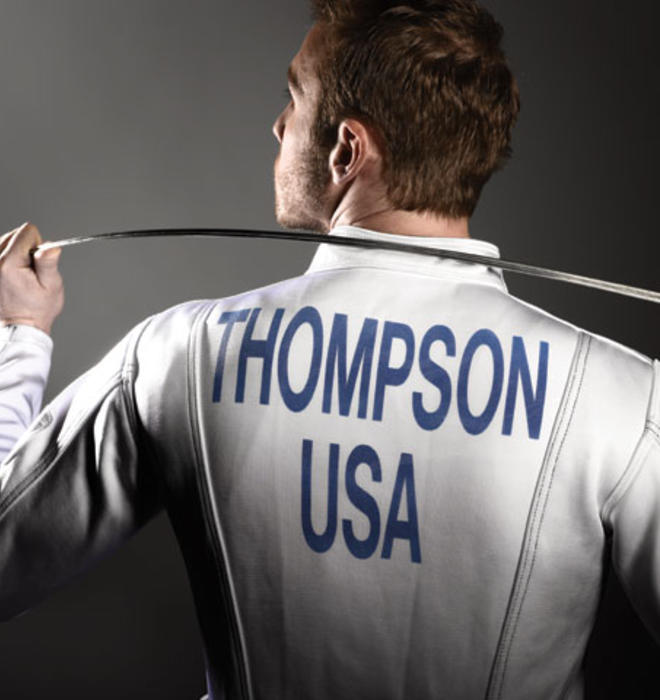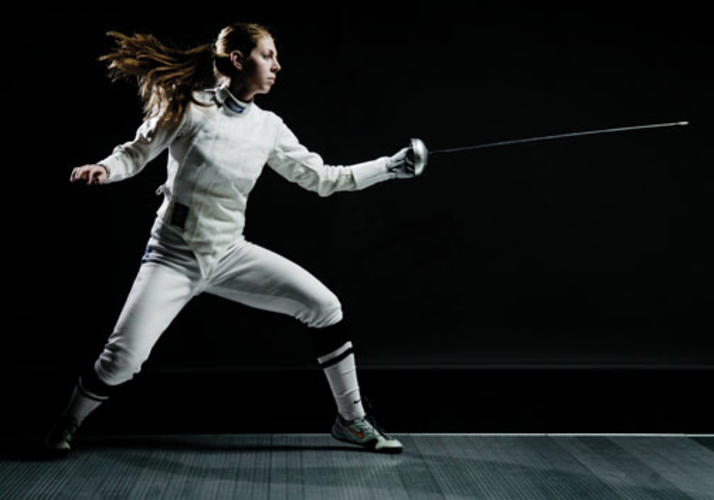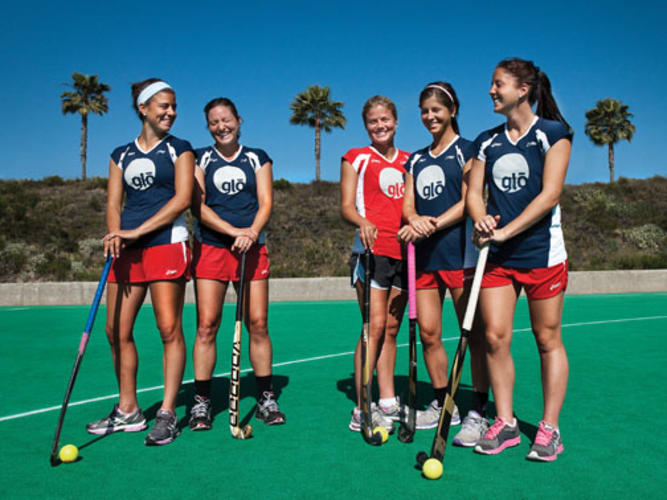
London calling
With the London Games set to begin later this month, PAW shines the spotlight on some of Princeton’s Olympians and Olympic hopefuls — and the paths they’ve traveled to reach the highest level of international competition.
When Soren Thompson ’05 walked away from fencing in 2008, the transition seemed natural. He had competed in the Olympics in 2004, finishing seventh in men’s epee, but fell short in 2008 after suffering a hamstring tear late in the qualifying cycle. Fencing was not going to be his career, so he took a job at a green-technology startup. He stayed in shape and competed in domestic tournaments, but his top-15 world ranking plummeted nearly 200 spots.
As the 2012 Olympic qualifying season approached, Thompson began to think about returning to the strip. This time, he’d be making enormous sacrifices, putting his career on hold and paying travel and training expenses — in a sport that holds every major event outside the United States.
Thompson decided to compete. He moved to a part-time work schedule and made an immediate splash in his sport, placing third in the Stockholm Epee Grand Prix in May 2011 to become an early favorite in the U.S. qualifying chase. A year later, he reached No. 8 in the world epee standings — a career best — and qualified for the London Olympics.
“I don’t think I’ve ever been involved in a process where I risked so much and then gained so much,” Thompson says.
Susannah Scanlan ’14, the youngest of Princeton’s Olympic epeeists, came to the University as a member of the Class of 2012 but took a two-year leave to compete for an Olympic spot. Qualification tournaments began in what would have been her junior year and stretched through 2011–12.
For much of that time, Scanlan was ranked sixth or seventh in the United States, just below the qualifying line. She scheduled a trip to visit a friend in San Diego in April, after the U.S. team would be named, to have something to look forward to in case she fell short.
But Scanlan’s fortunes took a positive turn in late February at the Budapest Epee Grand Prix, when she advanced to the championship draw, won her first two bouts, and finished in the top 16, surging into the third U.S. qualifying position. With an Olympic spot in hand, the San Diego trip went from consolation to celebration. A week later, she was back on the strip, ramping up her routine to prepare for London.
Scanlan says she’s excited about becoming a student again after the Olympics. “I was surprised at how much I missed class,” she says. “I don’t really miss problem sets, but I miss learning.”
In 2005, Maya Lawrence ’02 moved to Paris to teach English and practice fencing with a renowned French coach — a bold decision that helped her climb in the international rankings during the buildup to the 2008 Olympics.
Fencing in the final qualifying event, the young epeeist knew she needed one of her best results to stand a chance of representing the United States. She was just three seconds shy of advancing in an early round when one evasive move caused disaster. Lawrence parried and twisted, but her legs did not turn. The sudden movement tore a ligament in her knee, forcing her to drop out of the competition.
A year later in another international bout, Lawrence landed awkwardly and tore a ligament in the other knee. All told, she lost 18 months of training time, delaying her effort to prepare for the 2012 Olympics. But she pushed ahead, buoyed by her coaches and training partners. European fencers “are bred to think of themselves as professional athletes,” she says. “It wasn’t even a question as to whether or not I would [come back].”
Fast-forward to April 2012: After a productive year on the international circuit, Lawrence finished a strong second among U.S. women epeeists, earning the Olympic bid she’d been chasing for nearly a decade. Her first emotion was relief, quickly followed by elation. “There’s nothing quite like the Olympics,” Lawrence says. “Most people who are trying to go don’t go. So I feel lucky.”
On campus, the typical Princeton student’s schedule includes busy nights followed by sluggish mornings. But for the four undergrads training with the U.S. field hockey team in California, the order has flipped: Mornings are a flurry, while the nights are calm and quiet.
“It’s almost guaranteed that I’ll be in bed by 9 p.m.,” says Katie Reinprecht ’12, who shares a house with sister Julia ’13, Michelle Cesan ’13, Kathleen Sharkey ’12, and four other U.S. teammates.
The national team, which also includes Maren Langford ’06, has endured an exhausting year of training, scrimmaging, weightlifting, and conditioning — broken up by a handful of international tours and tournaments. Even on “off” days, each player is expected to complete a running workout.
The work seems to be paying off: The Princeton players all say they’re in the best shape of their lives, and after upsetting top-ranked Argentina to win the Pan American Games in late October, the United States looks like an Olympic medal contender.
Winning gold at the Pan Am Games guaranteed the United States a spot in London, and for the next eight months, Olympic roster positions were up for grabs. Competition within the team initially was a source of tension, Langford says, but the players quickly cleared that mental hurdle. “You can’t think about it,” she says. “If you do, no one is going to take risks and no one is going to get better.”
When the 16-player roster was selected June 11, it included two Tigers, Julia and Katie Reinprecht, with Cesan as an alternate.
The five Princeton players took different routes to the national team, but they have one thing in common: appreciation for Tigers head coach Kristen Holmes-Winn, a former national-team player who has supported each player’s Olympic ambition, providing encouragement with phone calls and messages.
“It’s nice to be reminded what you’re capable of,” Katie Reinprecht says. “Kristen
is really good at doing that.”
Rowing is a team pursuit in every event except one: the single scull. And according to Gevvie Stone ’07, the only U.S. rower to qualify for that Olympic event, training in the single “can be a little lonely.”
To fill the void, the Boston-based Stone assembled an informal team that includes her father, Gregg, a former U.S. national-team sculler; Harvard men’s lightweight coach Charley Butt; a handful of ultracompetitive men’s masters rowers who also train on the Charles River; and the Harvard women’s rowing program — sacrilege, she jokingly admits, but the team has welcomed her.
Stone chose sculling partly to suit her strengths and partly out of necessity: As a medical student at Tufts, she could not train with the other Olympic hopefuls in Princeton. She rowed for two years as a full-time student, passed the first step of her medical-board exams, and took a leave to concentrate on earning a spot in London.
Qualification came in late May at the event informally known as the Last Chance Regatta, held in Lucerne, Switzerland. With four Olympic spots up for grabs in a six-boat final, Stone started strong and never slipped from a qualifying position, finishing third. Her mother, 1976 Olympic rower Lisa Hansen, led the welcoming party at Logan Airport when she returned home.
After London, Stone plans to return to med school and begin her hospital rotations. But she has not ruled out another Olympic run in 2016. “I’m still getting faster, and I still love it,” she says. “I can’t imagine saying goodbye.”
Glenn Ochal ’08 started rowing as a high school student in Philadelphia, and from the beginning, he aimed to prove himself against elite competition. That ambition drew him to Princeton and helped propel him to a seat on the first-varsity eight as a sophomore. By senior year, he was captain of the Tiger heavyweights. A bid for the U.S. national team after graduation seemed like the logical next step.
Ochal joined the national program in the down time after the 2008 Beijing Olympics, training with about a dozen other athletes in Princeton while helping to coach the Tiger lightweights. With each year, the training group grew larger and the pressure more intense. In 2011, Ochal left coaching and moved to California to concentrate on a final Olympic push. He earned a spot on the men’s coxless four in early June.
During the buildup for London, Ochal has maintained focus with the knowledge that “every workout means something” — a fact that rowers track with each fraction of a second on the stopwatch. “It’s basically four years of work going into six minutes of racing,” he says. “The ratio is a little off, but it’s all worth it.”











1 Response
Sophia M. Echavarria ’09
9 Years AgoCovering female Olympians
I was pleasantly surprised to see that most of our Tiger Olympians (cover story, July 11) were amazing women, and then confused that none of them was on the cover.